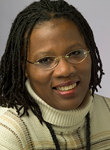Admissions office celebrates decade of success as leadership changes
By Susan Kelley

As Cornell's Office of Admissions and Enrollment celebrates a record number of applications, senior officials are looking back at a decade of achievement under its current leadership.
That leadership is about to change. After a decade at Cornell, Doris Davis, associate provost for admissions and enrollment, has announced she will leave the university after the spring semester to open an admissions consultancy serving international students.
In light of Davis' departure, Provost Kent Fuchs is taking the opportunity to evaluate how central admissions and financial aid should be organized for the future. He will announce his decisions by the end of the spring semester.
"Doris brought demonstrable success to our admissions and enrollment management functions, and we will miss her," said Fuchs. "She has been a model of collegiality, professionalism and entrepreneurial spirit, and I wish her the best with her new endeavors."
Since 2000, the university has streamlined the application process, increased student diversity, become more selective in admitting students and accepted more international students than ever; it has implemented an online application review process, enhanced its work with community-based organizations to specifically target low-income students and improved financial aid.
At the same time, Cornell continues to attract more students. More than 36,000 students applied for 3,150 places in the Class of 2014, a new high.
"I am proud of the enormous success we've had in increasing admissions applications to Cornell -- applications have increased over 65 percent since my arrival," said Davis. "I am also proud of the new financial aid programs that ensure that students from all socioeconomic backgrounds are able to afford a Cornell education."
In 2008, Cornell changed its financial aid system to let students with family incomes of less than $50,000 graduate debt-free.
At $9,775 in 2009-10, the average cost of attendance (net of financial aid) is the lowest in 10 years for families who earn less than $75,000 a year. The number of students who received $40,000 or more in grants almost doubled from 2008 to 2009. And 13 percent more undergraduates receive need-based aid, compared with 2008.
David Harris, deputy provost, attributes the admissions and enrollment success to leaders from across the campus -- from Doris Davis, and her staff to the college-based admissions offices, the Board of Trustees and President David Skorton.
"Access has long been a core value at Cornell," said Harris. "The actions of the past few years reflect a significant effort to ensure that our policies are aligned with our values.
Another big change in Cornell's admissions process in recent years was the 2004 adoption of what is known as the Common Application, which allows students to apply to multiple institutions with just one application. And in 2008, the university began allowing students to apply to two Cornell schools or colleges, reflecting students' varied academic interests.
During the same period, Cornell's student body became markedly more racially and ethnically diverse. Minority students represented 36 percent of the class in 2009, up from 28 percent in 1999.
And in the past 10 years, Cornell's acceptance rate became increasingly selective: 19 percent of applicants were admitted last year, compared with 33 percent 11 years ago.
"This is the sixth consecutive year that Cornell has experienced a boost in applications for undergraduate admissions," said Davis. "Our results this year, and the years prior, is the result of enormous outreach efforts by the admissions staff, the implementation of new financial aid programs, and the belief among students and parents that higher education, and a Cornell education in particular, is an important life-long investment."
A reception will be organized at the end of the semester to honor Davis.
Graduate School also receives record applications
Cornell's Graduate School has also seen continuing increases in applications. The 7,391 U.S. applicants for 2010 represents a 19 percent increase from fall 2008 and 8 percent increase from fall 2009. Underrepresented minority groups account for a significant portion of that increase -- applications from these groups were up 35 percent for fall 2008 and 11 percent for fall 2009.
International applications are up 14 percent for the students that entered fall 2008 and 10 percent for fall 2009. This increase may be an indication that the U.S. recession is not the only factor driving a rise in graduate school applications, said Alison G. Power, dean of the Graduate School.
"The increase in applications for all degree programs from both domestic and international students is an indication of the strength of Cornell's graduate programs and the high esteem in which they are held," she said.
Media Contact
Get Cornell news delivered right to your inbox.
Subscribe